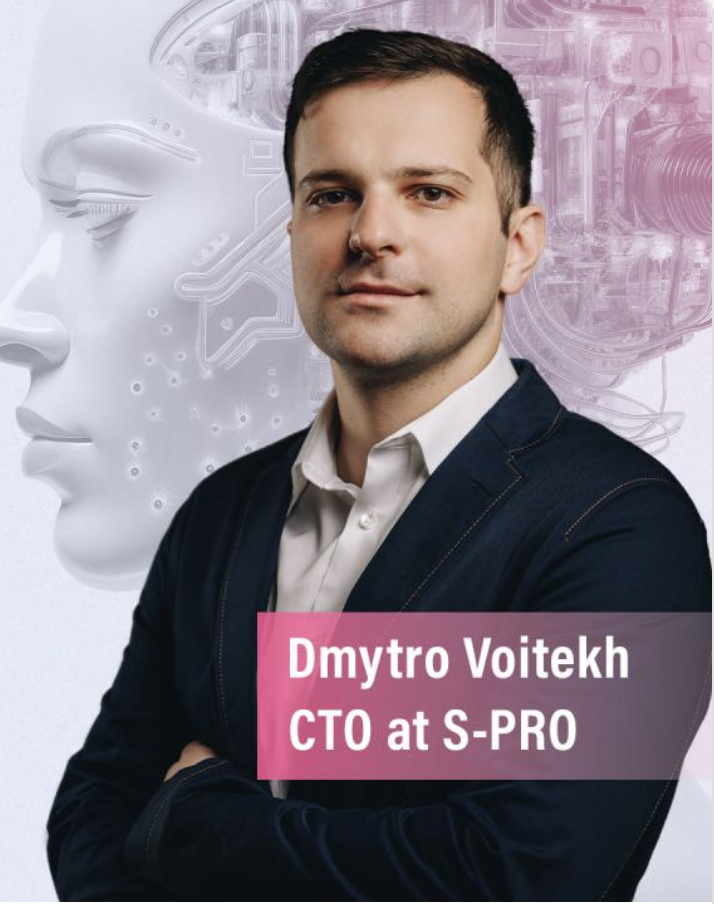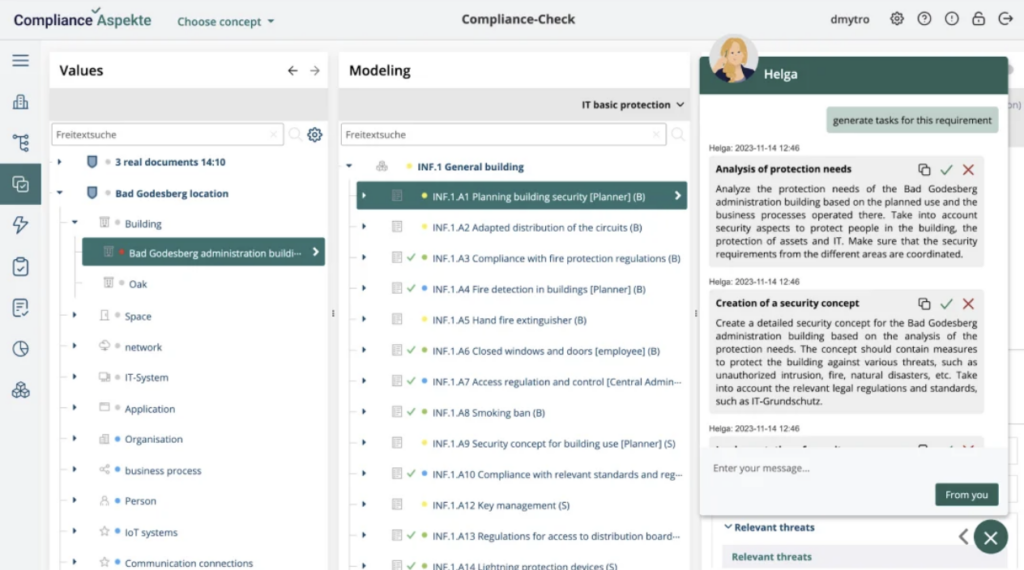In recent years, artificial intelligence (AI) has made incredible progress. Companies use AI to automate processes, analyze large amounts of data, and create innovative products. Statistics confirm such trends: spending on research and development of artificial intelligence has increased significantly — up to $150.2 billion in 2023. At the same time, the market size is expected to grow to $1,345.2 billion by 2030.
But how will this affect the labor market? While 31% of employees fear that AI will make their work obsolete, 60% feel the positive effect of technology on their work processes. Of course, to interact with AI, specialists should improve qualifications — companies believe that 40% of their workforce will require reskilling. Thus, we can rather talk about the role of AI in augmenting people and not replacing them with machines.
In this article, we will consider two main aspects: the impact of artificial intelligence in software development and what features should be considered when building an AI application.
The material was prepared with the help of an AI/ML expert — Dmytro Voitech, CTO at S-PRO. Dmytro led a team that built algorithms for an AI-based photo and video recognition program. He also had successful experience as a technical director at a startup that received investment from Google. In his spare time, Dmytro works on his AI-based project on Smart MicroGrid.

How AI Has Changed the Software Development Process
Did you know that 13% of companies use generative AI for software development? These technologies are most commonly employed to understand trends in user needs, draft technical documents, and create new product designs.
So, where to implement technologies for better efficiency? The good news is that any operation can be automated and improved with artificial intelligence tools. Let’s discover the benefits of AI in software development through the core stages.
Initial Stage
The role of AI in software development starts with idea generation, analysis, and planning. Algorithms look for trends and patterns in large amounts of data, inspiring specialists to build innovative functionality and UX design. For example, you can understand the market's needs by investigating social networks and user reviews of competitors' products.
What about planning? AI analyzes historical data, allowing for more accurate project timelines and resource needs estimates. In addition, you easily evaluate proposed features or products, predict their user adoption, and identify potential risks and problems.
Architecture and Design
Do you need help creating an optimal software architecture that considers productivity, scalability, and security requirements? AI for software developer simulates different scenarios, so you choose optimal solutions and avoid expensive redesigns at later development stages.
The AI system suggests design elements that will resonate precisely with the target audience. Use it to choose the right fonts, color schemes, and graphic elements (as Nutella did in 2017). Thus, specialists create and test different design versions to improve the user interface. In addition to A/B testing, AI helps you predictively evaluate the user experience and identify potential issues.
Development
According to a leading Gartner expert, coding assistance is among the top five AI use cases. To speed up modernization, the system translates code from old programming languages (COBOL) to modern SQL and Python.
Let’s improve your development processes with AI by automating routine, repetitive tasks. Also, AI systems generate code snippets based on patterns and requirements, detect anomalies, and suggest algorithms. Advanced tools review your code in real time and recommend improvements.
In addition, it is crucial to effectively manage dependencies between integrated elements. For example, systems anticipate conflicts between code segments or libraries, allowing developers to ensure smoother interoperability.
Testing
Testing and quality assurance processes will also benefit from implementing AI algorithms. In particular, you effectively analyze code to identify critical areas that require further investigation.
AI system analyzes the results of previous tests to determine the required amount of testing and cover the full range of scenarios. With these algorithms, you can easily adapt processes to add or change new functions.
Deployment and Maintenance
AI can help you optimize the deployment process, considering the application's requirements and the user environment. The system tracks metrics during the process, letting you identify and quickly resolve any issues.
In the context of maintenance, algorithms monitor software performance and predict potential failures to reduce downtime, increasing user satisfaction.
TOP 10 AI-Driven Tools for Software Development
Now, let's discuss the specific tools for software development artificial intelligence to streamline the process and resolve issues.
GitHub Copilot
Have you ever heard about GitHub Copilot? Based on your comment, it uses the OpenAI Codex language model to suggest entire lines or blocks of code. The tool integrates with various code editors and development environments — Visual Studio, Visual Studio Code, JetBrains, and Neovim. In addition, GitHub Copilot helps you fix code issues and identify security issues.
However, the code needs human editing. Also, the program's offerings can be improved.
Pricing: Copilot Individual ($10 monthly) with a free trial, Copilot Business ($19 per user monthly), and Copilot Enterprise ($39 per user monthly).
Tabnine
Tabnine analyzes large amounts of data to provide code completion suggestions and detect errors. Best of all, Tabnine automatically generates documentation, which is a lifesaver for developers who don't like or fear it. The tool works with various programming languages, including Python, Java, JavaScript, PHP, Go, and Rust.
As for limitations, the custom offerings will take time to adapt to your coding style, and the setup process can be overwhelming for junior developers.
Pricing: Basic (free), Pro (free for 3 months, then $12 per user monthly), and Enterprise ($39 per user monthly).
Mintlify
Mintlify examines the code and creates documentation according to your application's context, making writing manuals and quality assurance standards much easier.
Mintlify not only creates documentation but also evaluates its readability. Using natural language processing and web scraping capabilities, the platform scans existing information about documentation and user usage and recommends improvements. The tool integrates with GitHub, Slack, and Dropbox to automate task management and workflows.
The platform does not allow you to create documentation for the entire file at once. The company should also add more languages for user convenience.
Pricing: Free, Startup ($120 per project monthly), Growth ($400 per project monthly), and Enterprise (custom).
Mutable.ai
Mutable.ai helps you generate high-quality code based on text descriptions. It's like ChatGPT but more professional and narrowly focused. The system facilitates team collaboration, letting them easily communicate and work together on the code.
Mutable.ai supports multiple programming languages (Python, Go, JavaScript, TypeScript, and Solidity) and integrates with popular development environments like JetBrains and Visual Studio Code. This tool uses various methods to improve code readability and comprehensibility, as well as simplify test creation.
However, the tool may be ineffective in complex or domain-specific code logic or scenarios.
Pricing: Basic ($2 per repo monthly), Premium ($15 per repo monthly), Business ($50 per repo monthly), and Enterprise (custom).
AskCodi
AskCodi is an AI-powered tool that interprets natural language and converts it into code. Created with the OpenAI GPT-3 language model, it generates code with hints, automates tests, and translates the code description.
This is an excellent tool for beginner developers. Just install the AskCodi extension in your IDE and use it as your personal assistant, generating code and clarifying confusing points.
Disadvantages include limitations in accuracy, complexity, and natural language understanding. Users may also need time to get used to the learning curve and achieve optimal results.
Pricing: Free, Premium ($9.99 per user monthly), and Ultimate ($29.99 per user monthly).
Scribe
Want to simplify the creation and management of development documentation? Scribe generates manuals, tutorials, and SOPs, turning workflows into visual and understandable instructions. With its help, you can create documents with titles, descriptions, and personalized branding. Tools also allow you to edit screenshots and get tips as you go.
Scribe facilitates collaboration between team members and stakeholders, allowing users to easily capture, edit, and share content. The platform integrates with hundreds of other tools, from WordPress and Microsoft Teams to Airtable and ClickUp.
Users sometimes observe random reporting errors that may occur while working with the program.
Pricing: Free, Pro Team ($12 monthly), and Pro Personal ($23 monthly).
AlphaCode
DeepMind developed the AlphaCode model of artificial intelligence, trained on a large amount of text and code data. AlphaCode interprets problem descriptions through NLP and turns them into code.
The platform works with various programming languages, such as Python, C++, and Java. Developers can complete code based on contextual cues, reducing manual input errors. AlphaCode also detects and fixes issues and optimizes code performance.
Despite the model's capabilities, the generated code still needs human validation and testing to ensure its effectiveness and reliability. AlphaCode is not currently commercially available and has no set release date.
ClickUp
Development isn't just about writing code, considering effective project management at all stages. To accomplish this task, ClickUp uses automation, integration, and artificial intelligence features to automate documentation creation and quickly generate tests.
The platform also allows you to collaborate and improve project productivity with the help of roadmaps and sprints. You can prioritize tasks and track progress with Burndown and Burnup charts, while Gantt charts allow you to track milestones.
The large number of features can be among both the benefits of ClickUp and its limitations, confusing new users. Developers also note a long loading time.
Pricing: Free, Unlimited for small teams ($7 per user monthly), Business for mid-sized teams ($12 per user monthly), and Enterprise (custom).
TensorFlow
When talking about machine learning (especially deep learning), it is impossible not to mention TensorFlow, created by the Google Brain team. This system is open source and has powerful capabilities for learning and building neural networks. It is also useful for generating and optimizing code, automating tasks, etc.
The platform can use different data types and manipulations to gain more control over AI models. Working on a mobile device or focusing on web development? Meet the specialized tools TensorFlow Lite and TensorFlow.js.
Of course, this tool is best for more experienced developers due to its steep learning curve and difficulty understanding.
Pricing: Free and open source platform.
PyTorch
If you are interested in computer vision and natural language processing technologies, PyTorch is an absolute must-have.
An important feature of PyTorch is the dynamic computation graph, which allows flexible definition and modification of models. Do you want to optimize already created machine learning models? A large ecosystem of tools and libraries is at your service.
It is also not a very easy tool for novice ML engineers. In addition, PyTorch lacks monitoring tools.
Pricing: Free and open source platform.
AI-Powered Software: What It Is and What the Specifics of Development Are
What is AI software development? AI-powered software is a program equipped with artificial intelligence that can perform complex tasks, learn, and even make decisions independently.
Companies use such software for several reasons. They seek to automate routine tasks, analyze large data sets and find trends and correlations, predict events, or personalize the customer experience.
What technologies are used for this? Let's discuss the most common ones:
- Machine learning (ML) allows computers to learn from data, enabling them to solve very complex problems, from text classification to pattern recognition.
- Natural language processing (NLP) is used to analyze, understand, and generate human language. Thanks to this, computers can understand human speech and interact with people through text or voice.
- Computer vision studies the recognition and analysis of images and videos. This is needed to identify objects, persons, places, etc.
- Recommender systems investigate large amounts of user data and their behavior to recommend relevant products, content, or services.
- Expert systems solve complex problems that require specific knowledge or experience. These tasks range from diagnosing narrow medical diseases to planning production processes.
Now that we have discussed AI driven software definition and popular technologies, it is time to overview the specifics of developing such a system. What should you pay attention to?
- Before you start development, you must ensure the high quality of your data. If the data is incorrect, incomplete, or irrelevant, it will lead to inaccuracies in the AI model's results. The more data used to train the model, the better it will make decisions or predict events. Collected data should be cleaned and converted into the required format.
- The choice of algorithms is no less important. You can choose neural networks, clustering, regression, decision trees, or other methods depending on your needs and task characteristics.
- Model training is a long and resource-intensive process. Software developer AI should use the prepared data to train the selected algorithms. The more data and the more complex the model, the more difficult the task.
- After training the model, you can evaluate its performance using a test data set. To improve the results, adjust hyperparameters — learning speed, number of layers in the neural network, etc.
- Once the model is validated, it can finally be integrated into existing systems. But the work does not end there. As with any software, to remain relevant, you should update the AI model and its parameters and fix any issues you find.
Let's discuss a few more important points.
More complex models are better adapted to complex tasks and show good results, but they are energy-consuming and require large amounts of data for training. How can you achieve a balance between the complexity of the model and its effectiveness? It all depends on your task and resources, as simple tasks do not require many parameters.
Undertraining prevents the model from solving the task while overtraining worsens the results, as the model remembers noise and unnecessary details.
Successful AI Software Development: An Example
S-PRO has extensive experience in artificial intelligence software development, covering ambitious startups and enterprises. We satisfy the tech needs of companies in fields like fintech, logistics, renewable energy, hospitality, healthcare, and manufacturing.
We would like to tell you more about Compliance Aspekte — an AI-powered platform that simplifies compliance with GDPR, ISO 27001, and other standards. Initially, the system used rule-based algorithms and a basic chatbot for support. We developed a co-pilot system that manages user tasks, interacts with platform entities, and provides context-sensitive instructions.

Launched in September 2023 as a SaaS product, Compliance Aspekte has attracted the attention of large companies by automating manual work.
AI Driven Software Development: 5 Questions and Answers from an Expert
Q: How do you ensure data quality and integrity in AI powered software development projects?
Before using data for model training, we ensure that it has been collected from reliable sources and cleaned of inaccuracies, duplicates, anomalies, etc. We also standardize the data to make it more suitable for analysis.
Q: How do you approach the challenge of bias in AI algorithms within software development?
At S-PRO, we fight bias at all stages of product development. Our specialists analyze the data to identify and exclude possible internal and external influences. We use representative data from various sources, fine-tune algorithms and parameters, and then carefully test the results to ensure model objectivity.
Q: How do you address the computational complexity and resource requirements of training AI models in a software development context?
We use efficient algorithms and optimization methods to reduce the computational complexity and minimize the resources used. Parallel computing and distributed systems are also effective, as is the use of cloud platforms. If necessary, we could employ pre-trained models.
Q: How do you manage version control for AI models and datasets in software development projects?
To manage version control, our developers use systems like Git to store and track changes. It is also important to structure repositories carefully, use tags and branches, and document all changes. We use automation tools as part of the Continuous Integration and Continuous Deployment (CI/CD) practices.
Q: Can you provide an example of a project where AI significantly improved the software development process or outcome?
Yes, our Compliance Aspekte project automates the GDPR, ISO 27001, and other standards certification processes. The AI powered co-pilot system not only answers questions but also interacts with platform entities and manages user tasks.
Conclusion
AI and software development are going hand in hand, increasing the success of businesses that have already implemented technologies in their systems. At the same time, you do not necessarily have to create a new system from scratch — try updating the existing one and supplementing it with machine learning models. We will help in both cases, offering you the most suitable cooperation conditions.
Looking for reliable AI developers? Contact us to discuss details.





